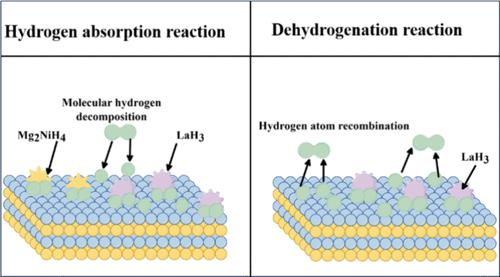Hydrogen Storage in Mg–Ni-Type Alloys with La and Sm Incorporation
IF 5.4
3区 材料科学
Q2 CHEMISTRY, PHYSICAL
引用次数: 0
Abstract
The addition of rare earth elements lanthanum and samarium to Mg–Ni-type alloys enhanced the hydrogen absorption and desorption kinetics. The microstructures of these alloys were characterized by using XRD, SEM, TEM, HTREM, and SAED methods. PCT equipment was employed to test the hydrogen storage performance. It was observed that Mg96NiLa3 alloys exhibited a more uniform and refined phase distribution, credited to the grain refinement effect triggered by Mg17La2. Additionally, the Mg96NiLa3 alloy demonstrated a significant hydrogen storage capacity, with hydrogen release reaching 6.2 wt % at 593 K, compared to 5.4 wt % for the Mg96NiSm3 alloy at the same temperature. The activation energies of dehydrogenation for Mg96NiLa3 and Mg96NiSm3 were 99.69 and 97.53 kJ/mol, respectively, with no significant difference considering errors. Similarly, the enthalpies of dehydrogenation were 72.9 kJ/mol of H2 for Mg96NiLa3 and 78 kJ/mol of H2 for Mg96NiSm3, indicating no notable distinction in the thermodynamic properties of the two alloys. Thus, the enhancement of the thermodynamic properties of Mg–Ni-type alloys by rare earth elements La and Sm appears to be insignificant.

掺入镭和钐的镁镍合金中的储氢技术
在镁镍合金中添加稀土元素镧和钐可增强氢吸收和解吸动力学。利用 XRD、SEM、TEM、HTREM 和 SAED 方法对这些合金的微观结构进行了表征。采用 PCT 设备测试了储氢性能。结果表明,Mg96NiLa3 合金的相分布更加均匀和细化,这归功于 Mg17La2 引发的晶粒细化效应。此外,Mg96NiLa3 合金还表现出显著的储氢能力,在 593 K 时的氢释放量达到 6.2 wt %,而在相同温度下 Mg96NiSm3 合金的氢释放量仅为 5.4 wt %。Mg96NiLa3 和 Mg96NiSm3 的脱氢活化能分别为 99.69 和 97.53 kJ/mol,考虑到误差,两者没有显著差异。同样,Mg96NiLa3 和 Mg96NiSm3 的脱氢焓分别为 72.9 kJ/mol H2 和 78 kJ/mol H2,表明这两种合金的热力学性质没有明显区别。因此,稀土元素 La 和 Sm 对 Mg-Ni- 型合金热力学性质的改善似乎微不足道。
本文章由计算机程序翻译,如有差异,请以英文原文为准。
求助全文
约1分钟内获得全文
求助全文
来源期刊

ACS Applied Energy Materials
Materials Science-Materials Chemistry
CiteScore
10.30
自引率
6.20%
发文量
1368
期刊介绍:
ACS Applied Energy Materials is an interdisciplinary journal publishing original research covering all aspects of materials, engineering, chemistry, physics and biology relevant to energy conversion and storage. The journal is devoted to reports of new and original experimental and theoretical research of an applied nature that integrate knowledge in the areas of materials, engineering, physics, bioscience, and chemistry into important energy applications.
 求助内容:
求助内容: 应助结果提醒方式:
应助结果提醒方式:


